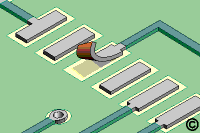No. 4.7.1
Surface Mount Pad Repair, Epoxy Method
OUTLINE
This method is used to replace damaged surface mount pads with commercially
available replacement pads. The new pads are bonded to the circuit board surface
using liquid epoxy.
CAUTION
It is essential that the board surface be smooth and flat. If the base material
is damaged see appropriate procedure.
NOTE
This method uses commercially available replacement surface mount pads. The new
pads are fabricated from copper foil. They are available in hundreds of sizes
and shapes and are generally supplied solder plated. If a special size or shape
is needed it can be custom fabricated.
TOOLS & MATERIALS
Circuit Frames, Pads
Cleaner
Epoxy
Flux, Liquid
Knife
Microscope
Oven
Scraper
Solder
Soldering Iron
Surface Mount Pad Repair Kit
Tape, Kapton
Tweezers
Wipes
PROCEDURE
- Clean the area.
- Remove the defective pad and a short length of the connecting circuit. (See
Figure 1).
- Use knife and scrape off any epoxy residue, contamination or burned material
from the board surface.
CAUTION
Abrasion operations can generate electrostatic charges.
- Scrape off any solder mask or coating from the connecting circuit. (See
Figure 1).
- Clean the area.
- Apply a small amount of liquid flux to the connection area on the board
surface and tin with solder. Clean the area. The length of the overlap solder
connection should be a minimum of 2 times the circuit width.
- The area for the new pad on the board surface must be smooth and flat. If
internal fibers of the board are exposed or if there are deep scratches in the
surface they should be repaired. Refer to appropriate procedure.
- Select a commercially available surface mount pad that most closely matches
the surface mount pad to be replaced. If a special size or shape is needed it
can be custom fabricated. (See Figure 2).
- Cut out and trim the new pad. Cut the length to provide the maximum
allowable circuit overlap for soldering. Minimum 2 times the circuit width. (See
Figure 3).
NOTE
The new replacement surface mount pad may be trimmed from copper sheet.
- Mix the epoxy and apply a small amount to the surface where the new pad will
be placed.
- Place a piece of Kapton tape over the top surface of the new pad.
Place the new pad into position on the circuit board surface using the Kapton tape to help
in alignment. (See Figure 4).
- Cure the epoxy per Procedure 2.7 Epoxy Mixing and Handling.
CAUTION
Some components may be sensitive to high temperature.
- After the epoxy has cured remove the Kapton tape used for
alignment. Carefully clean the area and inspect the new pad for proper
alignment.
- If the new pad has a connecting circuit apply a small amount of liquid flux
to the lap solder joint connection area and solder the circuit from the new pad
to the circuit on the circuit board surface. Use minimal flux and solder to ensure a
reliable connection. Kapton tape may be placed over the top of the new
pad to prevent excess solder overflow.
NOTE
If the configuration permits, the overlap solder joint connection should be a
minimum of 3.00 mm (0.125") from the related termination. This gap will
minimize the possibility of simultaneous reflow during soldering operations.
Refer to 7.1 Soldering Basics.
- Mix epoxy and coat the lap solder joint connections. Cure the epoxy per the
manufacturer's recommended instructions.
NOTE
Additional epoxy can be applied around the perimeter of the new pad to provide
additional bond strength.
- Apply surface coating to match prior coating as required.
EVALUATION
- Visual examination
- Measurement of new pad width and spacing.
- Electrical continuity measurement.
|
|
|
Solutions Across the Board
TM
|
|
|
|
Product Class: R/F/C
Skill Level: Advanced
Conformance Level: Medium
Revision: E
Revision Date: Jul 7, 2000
Repair Service Charge

Damaged Surface Mount Pad

Figure 1: Remove the defective pad and remove soldermask from the connecting
circuit.

Figure 2: Select a commercially available replacement pad that
matches the missing pad.

Figure 3: Cut out the new surface mount pad.

Figure 4:Place the new surface mount pad in place using Kapton tape.

Figure 5: Completed repair.
|
Tricks of the Trade
We nearly always use the film
adhesive method when replacing damaged or missing surface mount pads. Liquid
epoxy is difficult to control and may cause contamination. The film adhesive
method eliminates the potential problems of using liquid epoxy.
|
|
|
